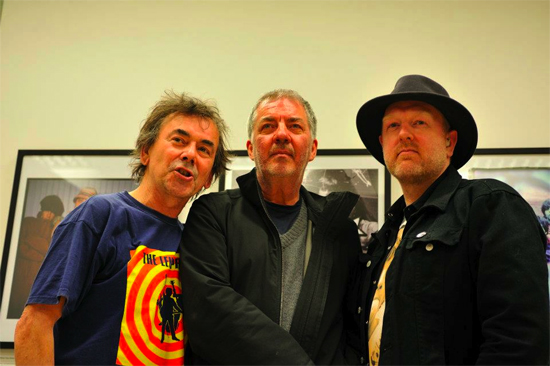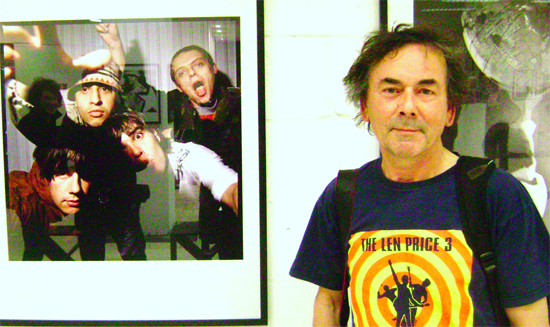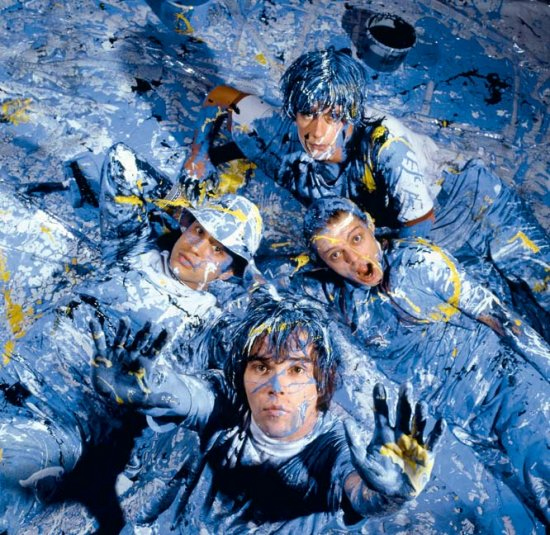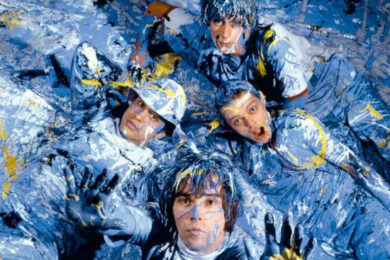The Stone Roses tour bus is now cranked up and on the road. Nostalgia is set to eleven. Out of the gloaming the band’s appointed commentators, biographers, photographers and caravans of believers have come tripping. You can’t miss this Happening. All the major music magazines have devoted covers, if not entire issues, to the clarion call of the Roses reunion in the last couple of months.
Mick Middles and John Robb have updated their classic biographies, and others like Simon Spence have produced brand new ones. Photographer Ian Tilton, with the writerly aide of his partner Claire Caldwell, is in the closing stages of production on Set In Stone, a coffee table portfolio collection of his iconic Roses images to be accompanied by a text that, amongst other things, promises to share some truths on synthesising magic from madness when working with a bunch of effervescent artists.
The Heaton Park shows are imminent. The Roses were greeted like messiahs in Barcelona as the tour sparked into action. Then there was that bit of pre-encore inter-group conipsis in Amsterdam last week. They seem to be keeping people guessing where exactly they’re really at.
Meanwhile down at Whiteley’s in Bayswater, curator Dave Brolan has brought in photographers Tilton, Kevin Cummins and Paul Slattery, ‘the big three’, for The Third Coming, a joint retrospective of their Roses photographs. The walls display frame after frame of celebrated images from the late 80s. Slattery’s pictures of the band in Japan. Tilton’s orange-in-the-beak Ian Brown portrait. Cummins’s insane paint-splattered composition (helped by John Squire’s handiwork). On the exhibition’s opening night, despite the fact that we’re in a West London proto-Ballardian shopping mall more suited to the hum of the shoppers shuffle than rave music, the space upstairs is well lit, beautifully organised and filled with an enormous crowd of London and Manchester faces by 7pm.

L-R: Paul Slattery, Kevin Cummins & Ian Tilton (photo by Paul Hughes)
The Quietus caught up with Kevin Cummins and Paul Slattery backstage to discuss the exhibition and the reunion, before what turned into a very late night for the main participants got properly underway.
"I think there’s such a thirst for this sort of nostalgia, and not just in England either," says Cummins. "I’ve done a couple of books over the last couple of years, and the Manchester book I did which covered Manchester music from 1976 to 2000 had so much press worldwide. Manchester’s almost become a brand for a certain type of music, but think there’s no other city in the world that has such longevity really. We’re kind of the Hollywood for music, aren’t we?"
Do you think that’s because there’s always been a fairly tight community of musicians, clubbers, journalists, promoters and so on – tighter than there is in London for example?
KC: Yeah, I think London’s too disparate, isn’t it? London’s a series of villages, so what happens in Clapham is totally different to what happens in Manor House. You might have a great scene in Peckham but nobody in Bayswater knows about it. Whereas Manchester has a small city centre and everybody goes to the same places. I’ve not lived there for 25 years but I go back to watch Man City play every weekend, and people think I still live there. They’ll carry on a conversation we’d been having three weeks earlier in the same pub.
Can you recall your first Roses ‘moment’?
KC: Yes. It was Howard Jones who was the manager at the Hacienda. He told me he was going to work with this band, and asked me if I’d like to photograph them, so I went to have a look. I took pictures of them in a park because they looked kind of – can I say ‘psycho-goth’, to be kind? – and they looked great but they didn’t have a great sound. I think at the time they were probably like a lot of bands when they first start, who maybe try too hard. They’d wind people up, and they’d spray paint the Stone Roses all over all the great buildings in Manchester, which annoyed a lot of people. Then they disappeared for about 18 months and came back, you know, changed the line up and brought Mani in. Then that was the classic line up and they became a very different band.
I think Mani and Reni as a drummer and bass player actually are the sound of the Roses, and weirdly John Squire’s guitar is slightly under that sound. When I went to see them in Barcelona at the start of the tour last weekend they sounded fantastic. They sound better now than they ever did, but it’s real funk and it’s real soul. When they played ‘Fool’s Gold’ and they got into that long groove it was almost like listening to George Clinton or someone like that. George Clinton would be proud of that moment – an eleven minute version of ‘Fool’s Gold’ that was just stunning.
Obviously the Roses’ image changed within the first few years quite a bit. Were you present and quite close to them through that whole period?
KC: Yeah I was really. When you work for a music paper – and I worked for a long time for the NME – I feel you have a responsibility to your reader to take your bands up a notch each time you photograph them. In the end I wanted to get what I considered to be a career defining image for the band, one that would have that longevity like the music. The first album still sounds as fresh now as it did twenty odd years ago because of the great production. Not just because all the elements were right, but because the production is fantastic and gives the album a timeless quality. I felt I’d done that photographically with Joy Division and I wanted to do it with the Stone Roses. So I thought, since John Squire did his own artwork and so on, it would be really interesting to try and get John to paint the band, and that would then become an enduring image that would be used for the band.
Did you get to hook up with them in Barcelona?
KC: Yeah, I did. I took some pictures of them live on the first day and then the second day I had a chat to Ian and Mani, mainly about football. They congratulated Man City on winning the league, through gritted teeth.
What kind of spirit are they in at the moment?
KC: Really high, they loved it and they got a real buzz off the audience. What I liked about it a lot is that when you go and see Noel and Liam and so on, you do get an awful lot of people who think it’s really really funny and adds to everybody’s enjoyment if they throw a cup of piss over the audience; whereas with the Roses there was just a lot of love in the audience. It was like being back in the late ‘80s, and everybody was having a brilliant time. People would apologise if they bumped into you. Very unusual, and I hope that carries on really.
A really personal question – do you have one favourite photograph that you’ve taken that you believe most personally reflects what you’ve tried to achieve out of a band presence, or an artist presence, or…
KC: Yeah. I took a really nice picture of my mum in a hotel room in Paris looking out the window just before she died, and that’s my absolute favourite.

Paul Slattery (photo by Helen Donlon)
Paul, how come, as a Londoner, you have such a strong Manchester connection?
Paul Slattery: Yeah, I was born just down the road from here! I don’t know what it was really. I suppose in my early career in 1978 I met The Fall, the mad Mark E. Smith. I was working on Sounds magazine at the time and I first met him in London and then I went up to photograph him in Manchester a couple of times. A joy to be with Mark, you know, an unpredictable character and a brilliant poet and a great personality; a guy with a lot of charisma. I went up there again in 1979 to photograph Joy Division, which was fantastic. I got to know Ian Curtis and photographed them again. I spoke to Ian – just before he died – at the Moonlight Club in West Hampstead. Then in 1983 it was The Smiths.
Did you feel like you almost had two lives being this kind of Manchester guy but a Londoner?
PC: Well, you know, Mancunians are crazier than Londoners; they drink more and they smoke a lot more dope, and that was right up my street at the time. I was a young man who wanted to live life at the edge…
Was that what drew you to Oasis too, that kind of back to basic rock & roll ethic that they had in the middle of all the squeaky clean boyband rubbish?
PC: Yeah, I jumped headlong onto that bandwagon! Same with the Stone Roses too, who’d been around for a while at that point. In 1989, in fact, I was getting a bit pissed off with the music business. I’d been in it for about twelve years and there was the odd band here and there to photograph, but I was getting pissed off with the managers and the business and everything. So, you know, I was thinking of doing other stuff, and I was getting into fashion photography when an old friend of mine, Philip Hall, who was doing the publicity for the Stone Roses says ‘Why don’t you come down and see them?’ I did go and see them a couple of times, and the next thing I was on the road with them in Japan. That was wild, absolutely wild, and a lot of these pictures in this exhibition were taken on that tour.
Did you know when they came into your life that this was the beginning of something else?
PC: Well certainly after the tour of Japan I knew that they were going to be a huge band. I just knew they’d come home and be massive, and within six months of getting back they did Spike Island in front of 30,000 people. I got a bunch of good pictures there. As far as the quality of the gig goes it was’t a great gig, because as you know the wind was moving the wrong way from the Mersey into the crowd, and it was sending all the music backstage, which is the unfortunate thing. But it didn’t worry me as I was on the side of the stage and enjoyed every minute of it. And the band were and you can still see from the crowd they were enjoying every minute of it too so it was still an iconic gig to be at.
You must have got pretty tight with them in Japan.
PC: Yeah but I’ve never had any close relationships with rock & roll bands really. They do their thing and I do my thing. I go and photograph them, that’s what I do, but I’d never make it my private life. I love the music. I’m a rock n roll fan and I love to be on the side of the stage or at the front of the stage photographing the band. Or backstage after the gig, but I want to go home after that and enjoy my own private life. I don’t want to spend the rest of my life partying with bands. That’s the way to certain death!
What do you think about them getting back together?
PC: They’ve probably got a good chance because most of the bands around at the moment are shit, and that’s the truth, and I think a bunch of fifty year olds which is what they are can probably wipe the floor with most of the crap that’s around right now.
The Stone Roses: The Third Coming The Definitive Exhibition is on at The Space, Whiteley’s Bayswater until August 12th. Lois Wilson chairs a Q&A on the Manchester music scene with Kevin Cummins at Whiteleys tomorrow (Tuesday 26th June) at 7pm.



